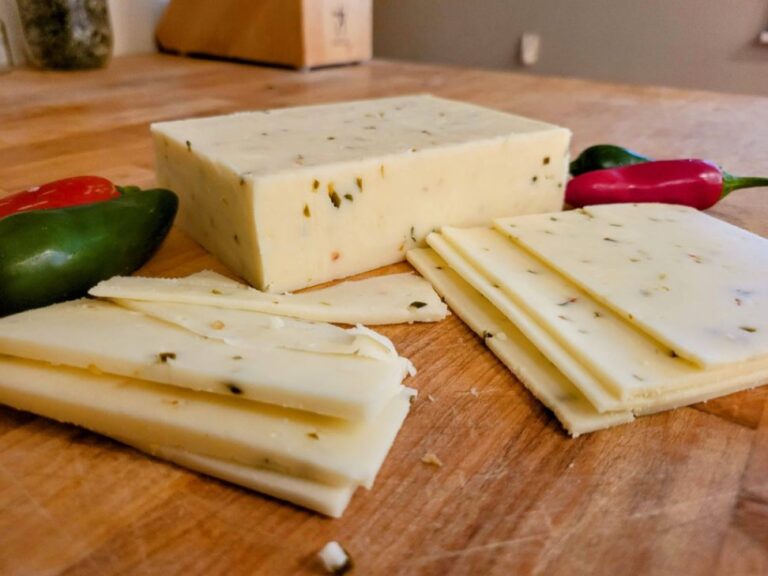Whether melted over nachos, stuffed into a quesadilla, or layered onto a sandwich, pepperjack cheese has become a staple in many households and restaurants. But what is pepperjack cheese?
Pepperjack cheese combines the creaminess of Monterey Jack cheese with the fiery kick of various peppers such as jalapenos or habaneros. It is a popular spicy cheese known for its smooth texture and bold flavor, adding depth and excitement to any dish it graces.
Pepperjack’s versatility and unique taste make it an irresistible choice for those who crave both heat and flavor in their meals. So buckle up and get ready to embark on a journey through the world of pepperjack cheese.
Table of Contents
Origins and Characteristics of Pepperjack Cheese
Pepperjack cheese is a flavorful cheese that originated in the United States during the 20th century. It was developed by blending Monterey Jack cheese with hot peppers, resulting in a unique and spicy flavor profile.
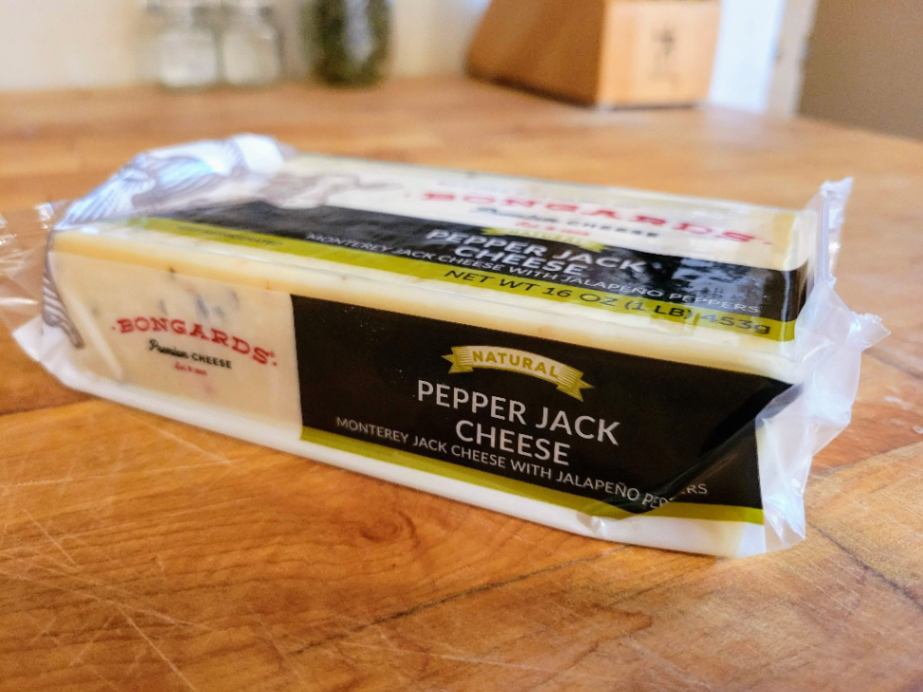
One of the defining characteristics of Pepperjack cheese is its spiciness. The heat level can vary depending on the type and amount of peppers used in the cheesemaking process. Commonly used peppers include jalapeños and sweet peppers. Adding these peppers gives Pepperjack its distinct taste and adds a kick to any dish it is used in.
The versatility of pepperjack cheese makes it ideal for various culinary creations. Its bold flavor can enhance sandwiches, burgers, quesadillas, and even macaroni and cheese dishes. When melted, Pepperjack adds a creamy consistency while infusing dishes with its signature spiciness.
Many people appreciate the burst of flavor that comes from incorporating Pepperjack into their meals. Whether you’re looking to spice up your tacos or add some excitement to your omelet, this cheese delivers on both taste and texture.
Pepperjack cheese complements well with ingredients like avocado, tomato, cilantro, and lime juice. These fresh components help balance out the heat from the cheese while adding additional layers of flavor.
If you enjoy spicy foods but prefer milder options, there are variations available that offer a toned-down version of Pepperjack’s spiciness. These milder versions still hint at heat without overwhelming the taste buds.
What Does Pepperjack Taste Like?
Mild to Moderate Spiciness of Pepperjack
Pepperjack cheese is known for its mild to moderate spiciness, making it a popular choice for those who enjoy a little kick in their dishes. The heat comes from adding jalapeno peppers or other spicy ingredients during the cheese-making process. Unlike some fiery hot sauces that leave your taste buds screaming for mercy, pepperjack cheese strikes a balance between flavor and spice.
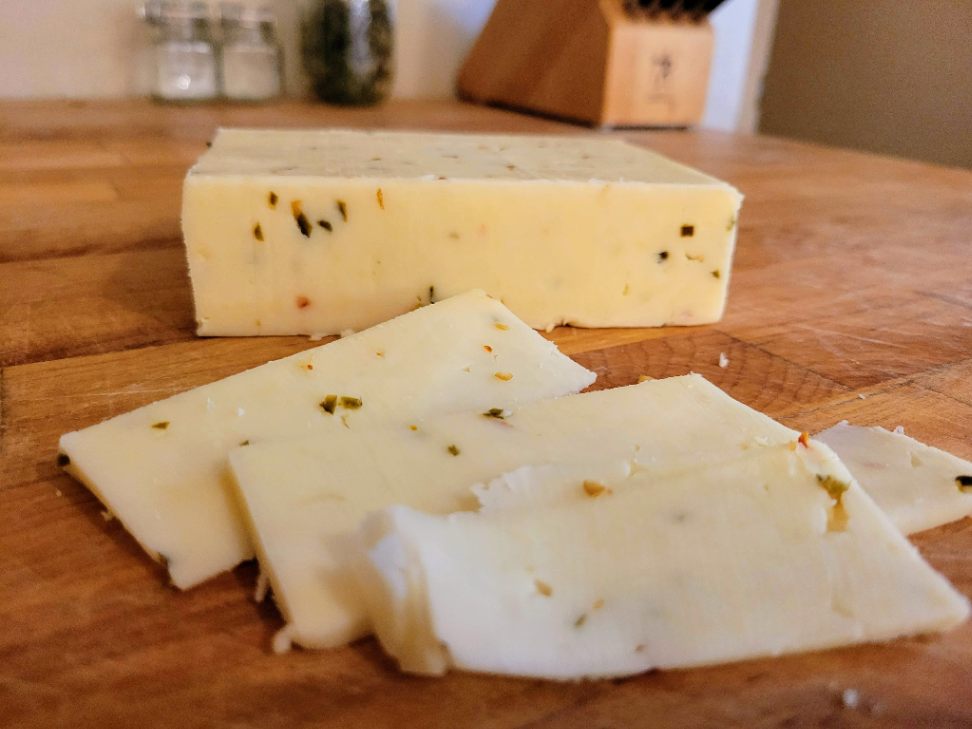
Pepperjack’s Creamy, Buttery Flavor Profile with Slight Tang
In addition to its spiciness, pepperjack cheese boasts a rich and creamy flavor profile. It has a distinct buttery taste that adds depth and richness to any dish. The creaminess is complemented by a slight tang, which gives the cheese an extra layer of complexity. This unique combination of flavors makes pepperjack cheese stand out from other varieties like cheddar or mozzarella.
Semi-firm Texture of Pepperjack: Easy to Slice
One notable characteristic of pepperjack cheese is its semi-firm texture. It falls somewhere between soft and hard cheeses, making it easy to slice without crumbling or becoming too rubbery. This feature makes it perfect for sandwiches, burgers, and even charcuterie boards. Whether you’re layering it on top of your favorite deli meats or adding it as a topping to your homemade pizza, pepperjack’s semi-firm texture ensures that each bite is satisfyingly cheesy.
Pepperjack Melts Smoothly
Another advantage of using pepperjack cheese in your recipes is its excellent melting capability. When subjected to heat, this cheese melts smoothly and evenly without separating into oily pools like some other varieties tend to do. This quality makes it ideal for grilled sandwiches, quesadillas, macaroni and cheese, or any dish that requires gooey melted goodness.
Pepperjack Cheese: A Flavorful Addition to Your Culinary Adventures
Pepperjack cheese is a versatile ingredient that can elevate the flavor of many dishes. Its mild to moderate spiciness adds a pleasant kick without overwhelming your taste buds. The creamy, buttery flavor profile with a hint of tang makes it an excellent choice for both savory and spicy recipes.
With its semi-firm texture, pepperjack cheese is easy to slice and perfect for layering in sandwiches or melting on top of burgers. Speaking of melting, this cheese melts smoothly and consistently, making it a dream come true for all the cheese lovers out there.
So, whether you’re looking to spice up your favorite sandwich or add some zing to your macaroni and cheese, give pepperjack cheese a try. Its unique flavor profile and versatile nature are sure to impress your taste buds and take your culinary adventures to new heights!
How is Pepperjack Cheese Made?
What Peppers Are In Pepperjack Cheese?
The most common pepper used in pepperjack cheese is the jalapeno pepper. These peppers add a kick of heat and a distinct flavor to the cheese. However, some variations of pepperjack may also include other types of peppers such as serrano or habanero, depending on the desired level of spiciness.
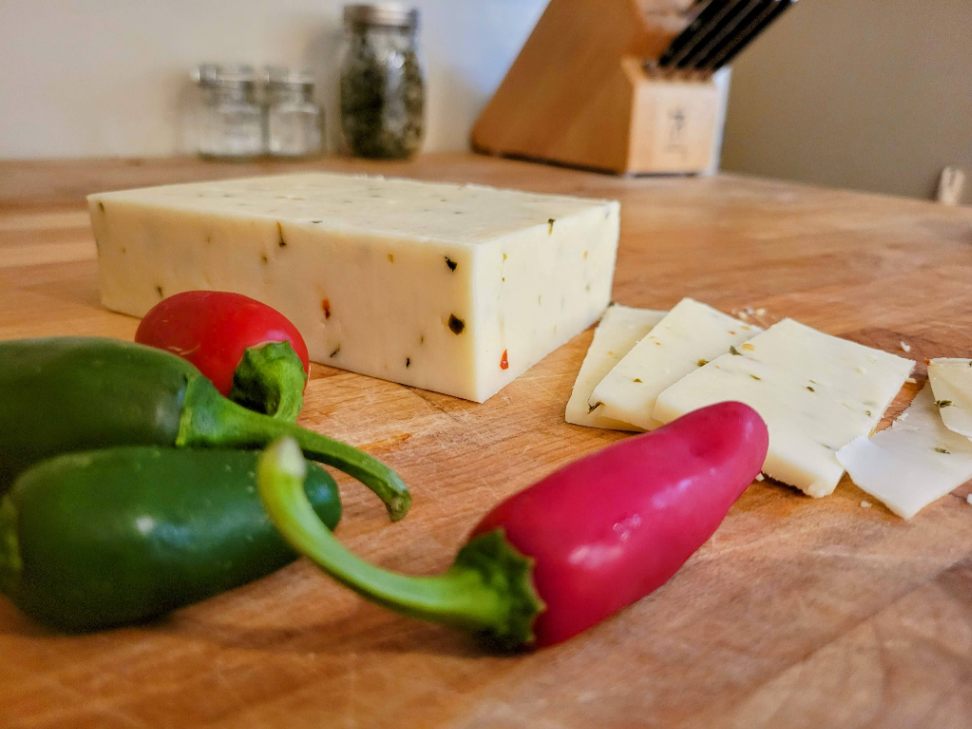
What Is In Pepperjack Cheese?
Pepperjack cheese is primarily made from cow’s milk, just like many other types of cheese. The milk used in cheesemaking undergoes a process known as pasteurization to ensure it is safe for consumption. Once the milk has been pasteurized, it is then mixed with cultures and rennet, which help in the curdling process.
To give pepperjack cheese its unique flavor and texture, other ingredients are added during production. One key ingredient is colby cheese. Colby cheese gives pepperjack its characteristic marbled appearance and smooth texture. Salt is added to enhance the flavor profile.
Process of Making Pepperjack Cheese
The process of making pepperjack cheese involves several steps to achieve its distinctive taste and texture:
- Milk Collection: High-quality cow’s milk is collected from dairy farms and transported to cheesemakers’ facilities.
- Pasteurization: The collected milk undergoes pasteurization, where it is heated to kill any harmful bacteria while preserving essential nutrients.
- Curdling: Cultures and rennet are added to the pasteurized milk, causing it to coagulate into curds.
- Cutting and Heating: The curds are cut into small pieces and heated gently until they reach a specific temperature.
- Draining: The whey (liquid) is drained off, leaving behind the curds.
- Cheddaring: The curds are stacked, flipped, and pressed to remove more whey and develop the desired texture.
- Mixing with Peppers: During this stage, the jalapeno (or other peppers) are added to the curds, ensuring an even distribution of flavor throughout the cheese.
- Salting: Salt is sprinkled on the curds to enhance taste and aid in preservation.
- Pressing: The curds are placed into molds or forms and pressed under weight to remove any remaining whey.
- Aging: Pepperjack cheese is typically aged for a few weeks to allow flavors to develop fully.
The result of this intricate process is a deliciously spicy cheese with a smooth texture and a tangy kick. Pepperjack cheese can be enjoyed on its own, melted into sandwiches or burgers, or used as an ingredient in various recipes.
Pairings and Uses of Pepperjack Cheese
Pepperjack cheese is like a chameleon in the culinary world – it can seamlessly blend into various dishes while adding a delightful kick to your taste buds.
- Mexican and Tex-Mex: A classic pairing for pepperjack cheese is with spicy foods like tacos or nachos. The creamy texture of the cheese beautifully balances out the heat, creating a harmonious flavor explosion in your mouth.
- Burgers and Sandwiches: You can also melt pepperjack cheese onto burgers or sandwiches for an extra zing that takes your meal to the next level.
- Eggs: Spice up your scrambled eggs or omelets with pepperjack cheese to add a bit of kick to your breakfast.
- Mac and Cheese: And if you’re feeling adventurous, try incorporating shredded pepperjack into macaroni and cheese for a twist on this comforting favorite.
Experiment with different recipes and see how this versatile cheese can elevate your meals to new heights. So go ahead, grab some pepperjack from your local store and embark on a culinary adventure that will leave you craving more!
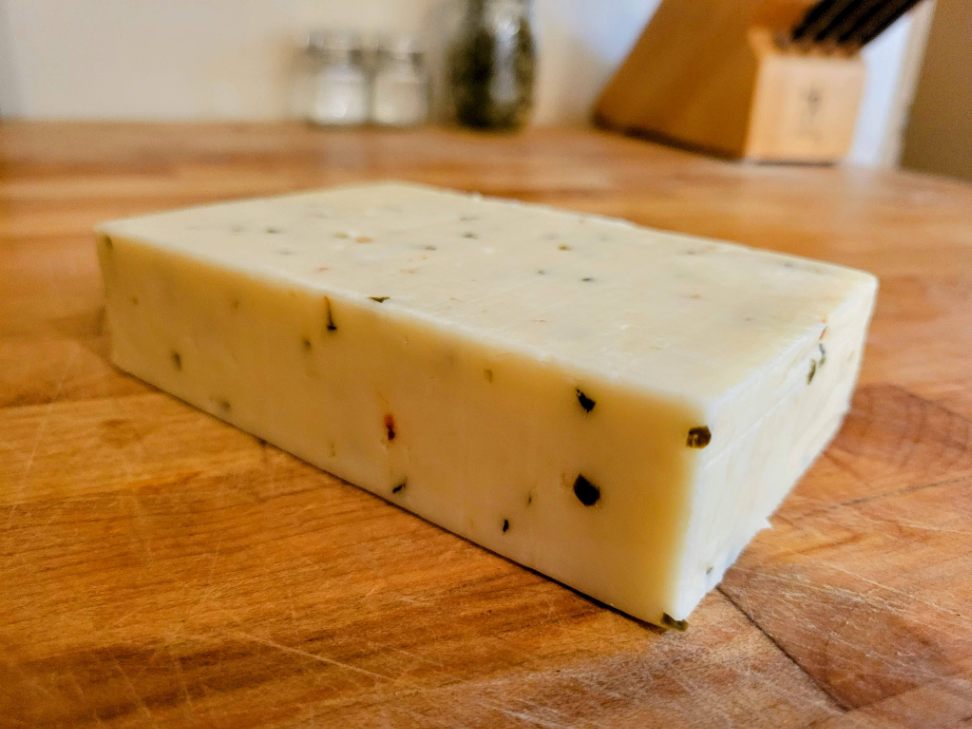
Frequently Asked Questions (FAQs)
Can I use pepperjack cheese as a substitute for other cheeses?
Pepperjack cheese can be used as a delicious substitute for traditional cheeses like cheddar or mozzarella in many recipes. Its unique flavor profile adds an exciting twist to dishes while still providing the melty goodness we all love.
Is pepperjack cheese suitable for vegetarians?
Most types of commercially available pepperjack cheeses are suitable for vegetarians as they are typically made using microbial rennet instead of animal-derived rennet.
How long does pepperjack cheese last?
When stored properly in the refrigerator at temperatures below 40°F (4°C), unopened blocks of pepperjack cheese can last up to four weeks past their expiration date. Once opened, it’s best consumed within one to two weeks for optimal flavor and texture.
Can I freeze pepperjack cheese?
While it is possible to freeze pepperjack cheese, the texture may change after thawing, resulting in a crumbly consistency. It’s best to consume fresh pepperjack cheese for the best taste and texture.
Are there any lactose-free options for pepperjack cheese?
There are lactose-free versions of pepperjack cheese available on the market. These options are made using lactase enzymes that break down lactose, making them suitable for individuals with lactose intolerance.

